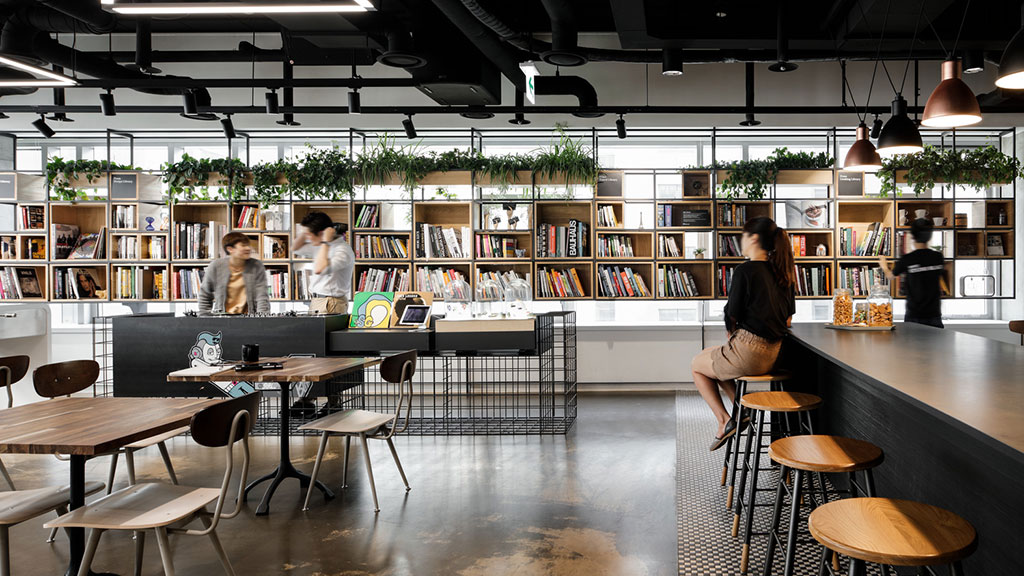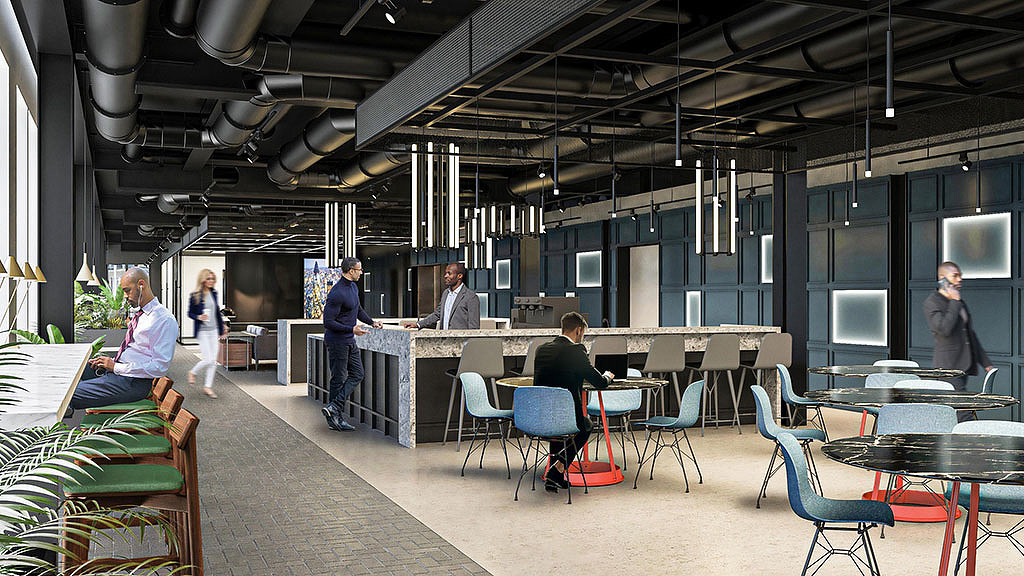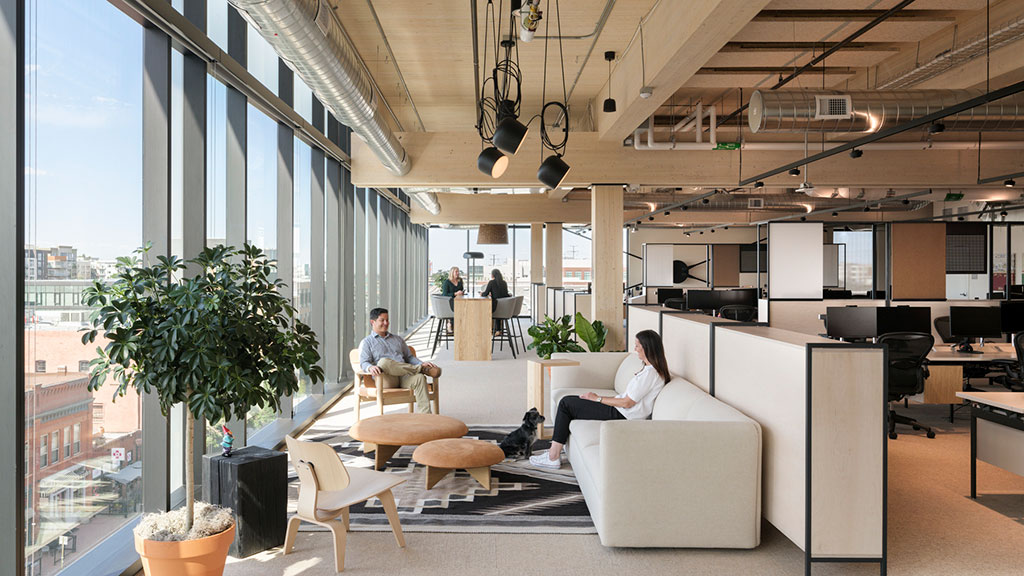(Re)Shaping the Future of Financial Services Firms in London
March 23, 2023 | By Adam Phillips
To kickstart the U.K. financial year 2024, let’s face the facts: the economic and geopolitical turbulence of the last three years will undoubtedly have a significant impact on where 2023 and 2024 takes us and the ever-changing world of work. Work remains in a state of constant transition, and we are still in the midst of the economic theatre of late 2022 — particularly in the U.K.
As work continues to evolve, the return to the office and city centers, along with new tech tools and digital transformations in work, life, and the marketplace will continue to shape the future of the Financial Services (FSF) workplace and inform decision making over the coming years.
Fast forward to today, and it could easily be argued that assigned desks and single-use space types have been traded for experience-based settings in the workplace. As we have seen a growth pattern of highly flexible, multi-modal work zones for FSF business, we have also seen a growth in quiet work settings for a majority of employees in financial services who need the office to carry out focus-based work.
Here are three meta trends that will continue to shape the financial services workplace and drive change for business, corporate real estate planning, and decision making:
1. The ‘20s are being defined by rapid change, resilience, and responsibility
Commercial real estate and the workplace are changing in response to the post-pandemic, high-inflation, and hybrid environment. With the current economic climate and outlook slightly bumpy, below are 10 ‘top of mind’ points shared among decision-makers, CEOs, and heads of business in the London market in 2023:
- Attract employees back to the office.
- Encourage in-person connectivity for team-learning and collaboration.
- Find cost-saving opportunities in short-term operations and long-term plans.
- Create environmental diversity so that employees can choose between work settings.
- Allow space to connect with teams and clients, as well as space for focus individual work, with a balance of ‘We’ and ‘Me’ space.
- Embrace, track, and trace ESG in global and local property portfolios, “aligning what we say with what we do. ”
- Put the big “S” in ESG in real-estate and corporate DEI targets.
- Drive innovation and client engagement for business growth.
- Support internal mentoring, growth, and networking.
- Provide effective work settings your employees need rather than maximizing seating capacity.
From new space-sharing rules that support hybrid work and minimum in-person mandates to trying to weave together corporate ESG goals into demonstrable workplace solutions that can be tracked, recorded, and shared, most organisations look to more effective approaches to real estate before considering space reductions for the future.
Is reducing real estate the best option for your organisation?Before considering space reduction, it is crucial that the core functions of the workplace not only support business organisation and ethos, but reflect a holistic approach to the needs of employees and teams. Reflecting on the amount of change over the past three years, the need to plan and allow for flexibility remains, especially as workstyle behaviours and technology continue to evolve and create new patterns in how we communicate and carry out individual and group-based work.
One of the best examples of this are businesses that are in transition from top-down to lateral teams and from lateral to agile teams with activity-based work environments. This has disrupted the norm to provide a choice of experience-based spaces that fulfill business needs to support growth, client relationships, and innovation — with potentially less square foot per head.

In principle, yes, it can help. In the world of commercial property, the lifecycle of commercial office space is inextricably linked to tenure of the lease, whether it be a flex, 10-year, or legacy. This influences the design and operational decisions that affect total embodied carbon and environmental impact of the space over time by the business. For shorter leases, we should be more aware of design specification and operational choices. This means maximising material reuse and recycled content in new construction, using furniture that supports the circular economy, and making responsible choices with renewable energy providers.
While there is debate on this, the general agreement is that you can do more with less, taking a large stride in your environmental impact and climate reduction goals by using less resources, raw materials, and energy, and still achieve a high-quality experience.
2. The A-Z office and purpose-driven destinations
The ‘workspace’ as a task-driven place to connect, share, and learn is taking a new form. While some organisations are recalibrating space needs, others are reimagining their current real estate footprint with more effective planning to put people first, promote team synergy, and enhance workplace well-being. This is often underpinned by comfort, biophilia, and neurodiversity.
We are welcoming the rise of purpose-driven environments that appeal to everyone across the business, serving far more than two or three functions. Businesses competing for talent and offices trying to lure employees back to the workplace are including the new macro (e.g.: coffee hub, innovation lab) and micro (e.g.: focus room, mindfulness suite) destinations, acting like magnets for people, teams, and businesses to be in-person.
While most of the industry swapped marathon travel schedules for virtual meetings, the need and demand for authentic in-person client meetings, albeit less frequent, has never been greater. Basic norms of business are unchanged, and spaces have been elevated for client experience and in-person engagements. The client-suite (C-Suite) has thus had a makeover, creating unique and memorably crafted experiences in-house that hinge on brand heritage and business ethos.
Here are the top 5 purpose-driven experiences that matter:- Multi-purpose event and conferencing spaces that can be used for a variety of different activities, from training to evening parties, to foster social connections and support in-person learning and development.
- Spaces that foster diversity, inclusion, and well-being, such as mother’s rooms, retreat spaces, and self-care spaces.
- Executive client suites showcasing the brand and nurturing client relationships through “third spaces” and high-quality service offerings, from wine and dining experiences to curated events.
- Embedding holistic biophilic design elements, indoor planting strategies, and a connection to fresh air and the outdoors.
- Leverage underutilised office space as an offer to subsidiary or corporate charity and community organisations, or for university outreach on days or weeks with low footfall. Could this be a potential solution to empty offices on Mondays, Fridays, and much of August?
3. In-person office experiences drive mentoring and business competition and spark creative solutions
In-person mentoring and learning is more effective for organisations that emphasise internal relationship building for career progression and inspire future decision-makers. Leadership in the industry will focus on training, mentoring, professional development, and onboarding to retain talent. Leaders are rethinking on-the-job training and onboarding by requesting in-person training sessions within their own sites (not offsite), especially for recent graduates and new hires to introduce new workplace setups and the value of face-to-face interaction.
In-person working drives internal competition among heads of business and traders. The most innovative financial service firms report having a flexible approach to office attendance but for compliance purposes traders are required to work in-person, despite even the FCA acknowledging remote and hybrid work is here to stay. During the pandemic, traders were allowed to trade from home for the first time. From the Gensler Trader Roundtable in 2020, we found that while some traders welcomed the change in work/lifestyle, they lacked the connection, drive, and competition among peers when compared to trading in-person, which helps to drive deals, business decisions, and building trust among peers.
In-person collaboration sparks creativity and drives innovation for FinTechs and other agile teams focused on complex problem-solving and product development. As FSF institutions have experienced explosive growth within their tech teams, so has the space in which they work. More than ever, they require hyper-flexible zones to support the creative process as well as multi-modal areas to learn, beta-test, collaborate, fail, disconnect, share, and celebrate. While some firms have dedicated innovation labs, this experimentation could be integrated around the office to foster curiosity among other teams and departments. The office, or select zones within the workspace, can be used to pilot planning options and test ideas around personalisation, new technology, and communication tools and processes that support developers and programmers, as well the larger business.
Lastly, FSF firms need to embrace a culture of innovation in their R+D or research platforms in lieu of just setting annual KPI’s. Gensler’s Culture of Innovation research outlined the organisational components of culture for the business and conditions of innovation for individuals and teams.
While the above may seem daunting, it represents where the financial services workplace experience is headed in London among the rapid rate of change we are experiencing across the capital.
Exacerbated by the need to drive growth, competition among firms for talent, and inevitably the next best product or service, is rife. Why not take a leading edge in providing a workplace experience that pushes your business, employees, and clients to flourish?
The office of yesterday is not coming back… so it’s time to change!
For media inquiries, email .


